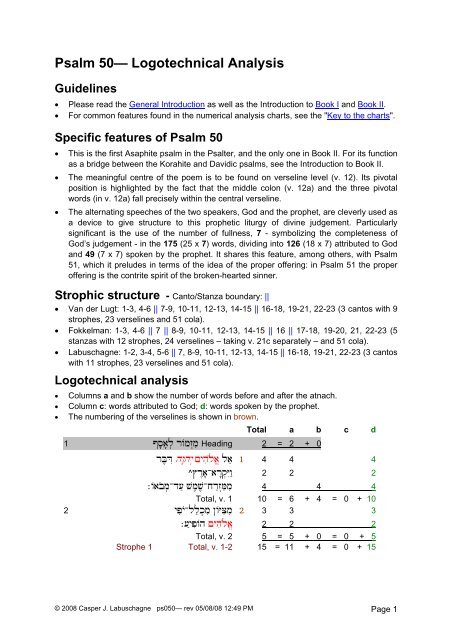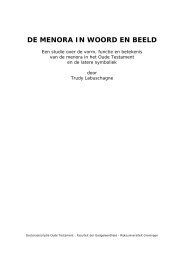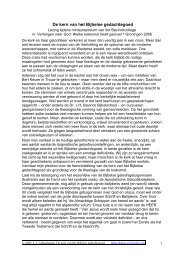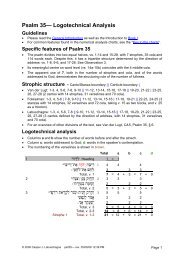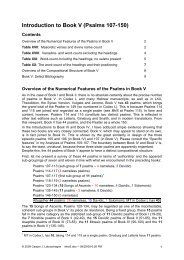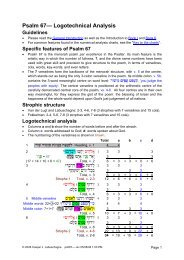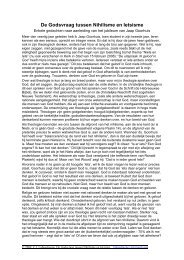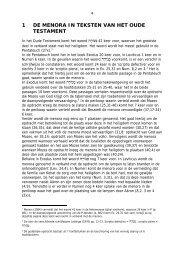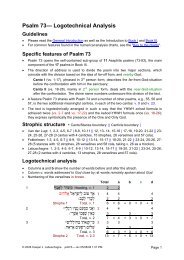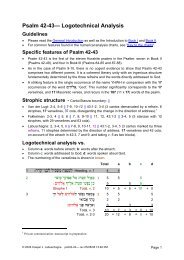Psalm 50 - labuschagne
Psalm 50 - labuschagne
Psalm 50 - labuschagne
Create successful ePaper yourself
Turn your PDF publications into a flip-book with our unique Google optimized e-Paper software.
<strong>Psalm</strong> <strong>50</strong>— Logotechnical Analysis<br />
Guidelines<br />
• Please read the General Introduction as well as the Introduction to Book I and Book II.<br />
• For common features found in the numerical analysis charts, see the "Key to the charts".<br />
Specific features of <strong>Psalm</strong> <strong>50</strong><br />
• This is the first Asaphite psalm in the Psalter, and the only one in Book II. For its function<br />
as a bridge between the Korahite and Davidic psalms, see the Introduction to Book II.<br />
• The meaningful centre of the poem is to be found on verseline level (v. 12). Its pivotal<br />
position is highlighted by the fact that the middle colon (v. 12a) and the three pivotal<br />
words (in v. 12a) fall precisely within the central verseline.<br />
• The alternating speeches of the two speakers, God and the prophet, are cleverly used as<br />
a device to give structure to this prophetic liturgy of divine judgement. Particularly<br />
significant is the use of the number of fullness, 7 - symbolizing the completeness of<br />
God’s judgement - in the 175 (25 x 7) words, dividing into 126 (18 x 7) attributed to God<br />
and 49 (7 x 7) spoken by the prophet. It shares this feature, among others, with <strong>Psalm</strong><br />
51, which it preludes in terms of the idea of the proper offering: in <strong>Psalm</strong> 51 the proper<br />
offering is the contrite spirit of the broken-hearted sinner.<br />
Strophic structure - Canto/Stanza boundary: ||<br />
• Van der Lugt: 1-3, 4-6 || 7-9, 10-11, 12-13, 14-15 || 16-18, 19-21, 22-23 (3 cantos with 9<br />
strophes, 23 verselines and 51 cola).<br />
• Fokkelman: 1-3, 4-6 || 7 || 8-9, 10-11, 12-13, 14-15 || 16 || 17-18, 19-20, 21, 22-23 (5<br />
stanzas with 12 strophes, 24 verselines – taking v. 21c separately – and 51 cola).<br />
• Labuschagne: 1-2, 3-4, 5-6 || 7, 8-9, 10-11, 12-13, 14-15 || 16-18, 19-21, 22-23 (3 cantos<br />
with 11 strophes, 23 verselines and 51 cola).<br />
Logotechnical analysis<br />
• Columns a and b show the number of words before and after the atnach.<br />
• Column c: words attributed to God; d: words spoken by the prophet.<br />
• The numbering of the verselines is shown in brown.<br />
Total a b c d<br />
1 •AsA'ļ rÙmÃzim Heading 2 = 2 + 0<br />
re–bÊ–d h√whÃy £yih»lÈ' lE' 1 4 4 4<br />
^ÂrA'-'flrŸq«Cy¬w 2 2 2<br />
:Ù'Ob¸m-dav HemeH-xfirÃziGmim 4 4 4<br />
Total, v. 1 10 = 6 + 4 = 0 + 10<br />
2 yipOy-lal¸kim §ÙCyiFcim 2 3 3 3<br />
:fivyipÙh £yih»lÈ' 2 2 2<br />
Total, v. 2 5 = 5 + 0 = 0 + 5<br />
Strophe 1 Total, v. 1-2 15 = 11 + 4 = 0 + 15<br />
© 2008 Casper J. Labuschagne ps0<strong>50</strong>— rev 05/08/08 12:49 PM Page 1
3 HfirÈx∆y-la'Ãw ˚nyEh»lÈ' '◊b√y 3 4 4 4<br />
^lEk'◊Gt wy√nAp¸l-HE' 3 3 3<br />
:dO'¸m hflr·v¸W«n wyAbyibş˚ 3 3 3<br />
Total, v. 3 10 = 7 + 3 = 0 + 10<br />
4 ^lAvEm £«yamAKHah-le' 'flrŸq«y 4 5 4 4<br />
:ÙGmav §yÊdAl ÂrA'Ah-le'Ãw 4 4 4<br />
Total, v. 4 8 = 4 + 4 = 0 + 8<br />
Strophe 2 Total, v. 3-4 18 = 11 + 7 = 0 + 18<br />
Total, v. 1-4 33 = 22 + 11 = 0 + 33<br />
5 ^yfldyis·x yil-˚p¸si' 5 3 3 3<br />
:xab√z-yEl·v yityÊr¸b yEtËrO–k 4 4 4<br />
Total, v. 5 7 = 3 + 4 = 7 + 0<br />
Total, v. 1-5 40 = 25 + 15 = 7 + 33<br />
6 ^ÙqËdic £«yamAH ˚dy«Fg¬Cy¬w 6 3 3 3<br />
:hAles '˚h XEpOH £yih»lÈ'-yi–k 4 4 4<br />
Total, v. 6 7 = 3 + 4 = 0 + 7<br />
Strophe 3 Total, v. 5-6 14 = 6 + 8 = 7 + 7<br />
Total, v. 4-6 22 = 10 + 12 = 7 + 15<br />
Total, v. 3-6 32 = 17 + 15 = 7 + 25<br />
Canto I Total, v. 1-6 47 = 28 + 19 = 7 + 40<br />
7 hflrE–bfid·'¬w yiGmav hAv¸miH 7 3 3 3<br />
^A–b hfldyivA'Ãw lE'flr¸W«y 3 3 3<br />
:yikOnA' ßyeh»lÈ' £yih»lÈ' 3 3 3<br />
Strophe 4 Total, v. 7 9 = 6 + 3 = 9 + 0<br />
8 ^ßexyikÙ' ßyexAbÃz-lav '◊l 8 4 4 4<br />
:dyimAt yÊ–dÃg∆n¸l ßyet»lÙvÃw 3 3 3<br />
Total, v. 8 7 = 4 + 3 = 7 + 0<br />
Total, v. 7-8 16 = 10 + 6 = 16 + 0<br />
9 ^rAp ߸tyE–bim x—–qe'-'◊l 9 4 4 4<br />
:£yÊd˚Gtav ßyetO'¸l¸kiGmim 2 2 2<br />
Total, v. 9 6 = 4 + 2 = 6 + 0<br />
Strophe 5 Total, v. 8-9 13 = 8 + 5 = 13 + 0<br />
10 ^rav√y-ÙtÃyax-lAk yil-yi–k 10 5 5 5<br />
:•elA'-y„rËrah¸–b tÙmEh¸–b 3 3 3<br />
Total, v. 10 8 = 5 + 3 = 8 + 0<br />
11 ^£yÊrAh •Ùv-lA–k yiGt¸vfid√y 11 4 4 4<br />
:yÊdAGmiv yfidAW zy«zÃw 3 3 3<br />
Total, v. 11 7 = 4 + 3 = 7 + 0<br />
Strophe 6 Total, v. 10-11 15 = 9 + 6 = 15 + 0<br />
Total, v. 8-11 28 = 17 + 11 = 28 + 0<br />
Total, v. 1-11 84 = 51 + 33 = 44 + 40<br />
12 Mid. colon: 25+1+25 ^Al ramO'-'◊l bavËre'-£i' 12 5 5 5<br />
© 2008 Casper J. Labuschagne ps0<strong>50</strong>— rev 05/08/08 12:49 PM Page 2
Middle words: 86 + 3 + 86 :–hA'»l¸m˚ lEbEt yil-yi–k 4 4 4<br />
Middle verseline: 23 = 11 + 1 + 11 Total, v. 12 9 = 5 + 4 = 9 + 0<br />
13 ^£yÊryi–ba' raW¸–b lakÙ'ah 13 3 3 3<br />
:heGtḨe' £yÊd˚Gtav £fidÃw 3 3 3<br />
Total, v. 13 6 = 3 + 3 = 6 + 0<br />
Strophe 7 Total, v. 12-13 15 = 8 + 7 = 15 + 0<br />
Total, v. 10-13 30 = 17 + 13 = 30 + 0<br />
Total, v. 7-13 52 = 31 + 21 = 52 + 0<br />
14 ^hfldÙGt £yih»l'El xabÃz 14 3 3 3<br />
:ßyÂrfldÃn §Ùy¸lev¸l £EGlaHÃw 3 3 3<br />
Total, v. 14 6 = 3 + 3 = 0 + 6<br />
15 ^hflrAc £Ùy¸–b y«nE'flrŸq˚ 15 3 3 3<br />
LXX hAles :y«n„d¸–bak¸t˚ ߸ceGlax·' 2 2 2<br />
Total, v. 15 5 = 3 + 2 = 5 + 0<br />
Strophe 8 Total, v. 14-15 11 = 6 + 5 = 5 + 6<br />
Total, v. 12-15 26 = 14 + 12 = 20 + 6<br />
Canto II Total, v. 7-15 63 = 37 + 26 = 57 + 6<br />
Total, v. 5-15 77 = 43 + 34 = 64 + 13<br />
Total, v. 4-15 85 = 47 + 38 = 64 + 21<br />
Total, v. 1-15 110 = 65 + 45 = 64 + 46<br />
16 £yih»lÈ' ramA' vAHflrAlÃw 16 3 3 3<br />
^y“–qux rEKpas¸l ߸Gl-ham 4 4 4<br />
:ßyip-yEl·v yityÊr¸b 'AKWiGt¬w 4 4 4<br />
Total, v. 16 11 = 7 + 4 = 8 + 3<br />
17 ^rAs˚m At'≈nAW hAGta'Ãw 17 3 3 3<br />
:ßyÂr·xa' yfirAbË–d El¸HaGt¬w 3 3 3<br />
Total, v. 17 6 = 3 + 3 = 6 + 0<br />
Total, v. 16-17 17 = 10 + 7 = 14 + 3<br />
18 ^ÙGmiv ÂriGt¬w b√Fn¬g Atyi'flr-£i' 18 5 5 5<br />
:ß’q¸lex £yip·'√n¸m £ivÃw 3 3 3<br />
Total, v. 18 8 = 5 + 3 = 8 + 0<br />
Strophe 9 Total, v. 16-18 25 = 15 + 10 = 22 + 3<br />
19 ^hAvflr¸b AGt¸xalAH ßyiKp 19 3 3 3<br />
:hAmËrim dyim¸caGt ßÃnÙH¸l˚ 3 3 3<br />
Total, v. 19 6 = 3 + 3 = 6 + 0<br />
20 ^rE–bfid¸t ßyixA'¸–b bEHEGt 20 3 3 3<br />
:yipO–d-§eGtiGt ߸Gmi'-§eb¸–b 4 4 4<br />
Total, v. 20 7 = 3 + 4 = 7 + 0<br />
Total, v. 16-20 38 = 21 + 17 = 35 + 3<br />
© 2008 Casper J. Labuschagne ps0<strong>50</strong>— rev 05/08/08 12:49 PM Page 3
21 yiGt¸HfirÈxehÃw AtyiWAv heGlE' 21 3 3 3<br />
^ßÙmAk h∆y¸he'-tÙyÈh AtyiGmÊ–d 4 4 4<br />
:ßy∆nyEv¸l hAkËreve'Ãw ß·xyikÙ' 3 3 3<br />
Total, v. 21 10 = 7 + 3 = 10 + 0<br />
Strophe 10 Total, v. 19-21 23 = 13 + 10 = 23 + 0<br />
Total, v. 18-21 31 = 18 + 13 = 31 + 0<br />
Total, v. 14-21 59 = 34 + 25 = <strong>50</strong> + 9<br />
22 ^fi–hÙlÈ' yEx¸kOH t'◊z '√n-˚nyi–b 22 5 5 5<br />
:lyiFcam §yE'Ãw •Or¸Xe'-§eKp 4 4 4<br />
Total, v. 22 9 = 5 + 4 = 9 + 0<br />
23 Coda ^Âr–d £AWÃw y«nÃnfld¸–bakÃy hfldÙGt fixEbOz 23 5 5 5<br />
:£yih»lÈ' vaH≈y¸–b ˚Fne'Ëra' 3 3 3<br />
Total, v. 23 8 = 5 + 3 = 8 + 0<br />
Strophe 11 Total, v. 22-23 17 = 10 + 7 = 17 + 0<br />
Numerical Total, v. 16-20 38 = 21 + 17 = 35 + 3<br />
chiasmus Total, v. 21-23 27 = 17 + 10 = 27 + 0<br />
Canto III Total, v. 16-23 65 = 38 + 27 = 62 + 3<br />
Total, v. 7-23 128 = 75 + 53 = 119 + 9<br />
Total, v. 4-23 1<strong>50</strong> = 85 + 65 = 126 + 24<br />
Total, v. 1-23 175 = 103 + 72 = 126 + 49<br />
With the heading and hAles (1x), v. 1-23 178 = 105 + 73<br />
Observations<br />
1. The middle words of the psalm are to be found in v. 12a, Al ramO'-'◊l, 'I would not tell<br />
you' (175 = 86 + 3 + 86), but they do not constitute a satisfactory meaningful centre.<br />
We may consider the middle verseline, v. 12 (23 = 11 + 1 + 11):<br />
:–hA'»l¸m˚ lEbEt yil-yi–k ^ Al ramO'-'◊l bavËre'-£i'<br />
If I were hungry, I would not tell you // for the world and all that is in it are mine.<br />
This does not sound particularly meaningful, which raises the question whether the<br />
author really endeavoured to contrive a meaningful centre in terms of words or poetic<br />
building blocks.<br />
However, in terms of the divine speeches, God’s 52-word address to his people<br />
about sacrifices in the heart of the poem (vs. 7-13) would be a most appropriate<br />
candidate. See below.<br />
2. The psalm is skilfully structured by the divine speeches (Column c) and the prophet's<br />
introductions and responses to them (Column d). Significantly, the 126 words<br />
attributed to God and the 49 spoken by the prophet are both multiples of 7 (18 x 7<br />
and 7 x 7 respectively). Additionally, God’s summons to his people (v. 5) and the first<br />
response by the prophet (v. 6) are both made up of 7 words. The function of the<br />
number of fullness is obviously to symbolize the completeness of God's judgement.<br />
The compositional structure of the psalm based on the speeches is in accordance<br />
with my view of the strophic and canto-structure, Canto I (Strophes 1-3), Canto II<br />
(Strophes 4-8), and Canto III (Strophes 9-11):<br />
© 2008 Casper J. Labuschagne ps0<strong>50</strong>— rev 05/08/08 12:49 PM Page 4
vs. 1-4 The prophet: Hark! The advance of the Judge! 33<br />
v. 5 God summons his covenant people 7<br />
v. 6 The prophet: response to the Judge’s summons 7<br />
vs. 7-13 God addresses his people about sacrifices 52<br />
v. 14 The prophet: offer praise as your sacrifice 6<br />
v. 15 God promises to rescue his people 5<br />
v. 16a The prophet: God will now speak to the wicked 3<br />
vs. 16b-21 God addresses the wicked in particular 45<br />
vs. 22-23 God addresses all those who forget God 17<br />
vs. 1-23 The entire prophetic liturgy of divine judgement 126 49<br />
The first divine speech, God’s summons, is addressed specifically to the members of<br />
the covenant (v. 5). It is followed by the prophet's response (v. 6), concluded in the<br />
Masoretic text by selah which clearly functions as a device to differentiate God’s<br />
summons and the prophet's response (vs. 5-6) from the major speech addressed to<br />
the people (vs. 7-15). In order to differentiate this major speech (vs. 7-15) from the<br />
final major speech addressed particularly to the wicked (vs. 16-23), the LXX has<br />
another selah at the end of v. 15 (absent in the MT version in Codex L).<br />
3. The major speeches in Canto I and Canto II are additionally demarcated by the selah<br />
at the end of v. 6 and by the refrain-like divine invitation in vs. 15 and 23. See <strong>Psalm</strong><br />
49:13 and 21 for the same technique, and compare <strong>Psalm</strong> 48:9 and 15.<br />
4. It is important to note that the first major divine speech (vs. 7-13) comprises exactly<br />
52 (2 x 26) words, which symbolizes God's presence in the divine judgement.<br />
Also worth noting is the sudden switch to 2 nd person plural in v. 22, at the end of the<br />
second major divine speech addressed to the wicked in Canto III: 'those who ignore<br />
God'. The change in number is a consciously utilized device to draw special attention<br />
to what is said in the concluding verselines 22-23. They are significantly made up of<br />
17 words, once again symbolizing God's presence.<br />
But there is more to it; the final verseline (v. 23) is clearly a coda, because it stands<br />
out within the final strophe by the abrupt return to 2 nd person singular and by being a<br />
refrain-like divine invitation like the one in v. 15. For the coda, consult the General<br />
Introduction, “The use of a coda as a device for conclusion”.<br />
It is important to note that, in addition to the psalm as a whole, the coda also preludes<br />
<strong>Psalm</strong> 51 by referring explicitly to the sacrifice that honours God. In <strong>Psalm</strong> 51, it is<br />
the offering of the contrite spirit of the broken-hearted sinner who confesses his guilt.<br />
5. Despite his use of the primary structuring number 7, the author still managed to<br />
weave the divine name numbers into the fabric of the text. Note the marked<br />
preference for the divine name number 17:<br />
vs. 3-6 17 words after atnach<br />
vs. 8-11 17 words before atnach<br />
vs. 1-11 51 (3 x 17) words before atnach<br />
vs. 10-13 17 words before atnach<br />
vs. 7-13 52 (2 x 26) words in God’s major address to Israel<br />
vs. 12-15 26 words in total<br />
vs. 7-15 26 words after atnach<br />
vs. 5-15 34 (2 x 17) words after atnach<br />
© 2008 Casper J. Labuschagne ps0<strong>50</strong>— rev 05/08/08 12:49 PM Page 5
vs. 4-15 85 (5 x 17) in total<br />
vs. 16-17 17 words in total<br />
vs. 16-20 17 words after atnach<br />
vs. 14-21 34 (2 x 17) words before atnach<br />
vs. 22-23 17 words in God’s address to those who forget him<br />
vs. 21-23 17 words before atnach<br />
vs. 7-23 119 (7 x 17) words in total in the four divine speeches<br />
vs. 4-23 85 (5 x 17) words before atnach<br />
vs. 1-23 51 (3 x 17) cola in total.<br />
6. The name hwhy occurs only once (v. 1), and so do lE' (v. 1) and fi–hÙlÈ' (v. 22); the<br />
designation £yih»lÈ', 'God', occurs 9 times.<br />
© 2008<br />
Dr. C.J. Labuschagne<br />
Brinkhorst 44<br />
9751 AT Haren (Gron)<br />
The Netherlands<br />
<strong>labuschagne</strong>.cj@planet.nl<br />
Senior Lecturer in Semitic Languages (retired),<br />
University of Pretoria, South Africa<br />
and<br />
Professor of Old Testament (retired),<br />
University of Groningen, The Netherlands<br />
© 2008 Casper J. Labuschagne ps0<strong>50</strong>— rev 05/08/08 12:49 PM Page 6


